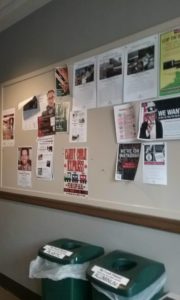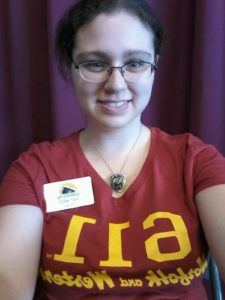I had meant to do this post before the break but never got around to actually finishing it due to all the craziness surrounding midterms. A large part of our time at the museum the weeks before break involved us preparing for the extremely popular Ghost walk event. Luminaries had to made, costumes be found and deep storage, and parts of the museum rearranged for the community weekend. I also helped get some members of the historical society at Roanoke involved to get some much needed volunteer work at the event. Unfortunately I was not able to participate because I left early Friday and did not return to late Sunday during East hills ghost walk, and was at home during the performance at Sherwood. Our next big project is the Christmas toys exhibit, which will be a an event that sees the entire museum turned into a interactive experience about Christmas’ past.
I have been having a lot of fun working at the museum this semester, I honestly look forward to going in every Wednesday. People in the community can be very passionate about local history and it feels great to share it with them. It has surprised me how lively the museum is, from the outside the seem like silent stuffy places, but the constant stream of community involvement and friendly people makes every day special and fun. There is also a lot of satisfaction gained when the events go well, which they all have since I have started. I am also becoming more and more comfortable with using past perfect and finding things within the museum collection. Its not my favorite task, but Accessioning items into the collection is something I am now comfortable doing on my own. (most of the time)

While prepping for the next exhibit we decided that a Hoop and Stick was a good representation of pre 1900’s toys, naturally we had to figure out how to actually play with it.







 The picture to the left doesn’t seem like it’s of much except maybe a few unmaintained grave sites, when it’s actually of an entire cemetery. We had driven over two hours from Salem to look at a couple mortuary sites on a farmhouse property a family had purchased, a common find on properties in the southwest Virginia region. As I’ve learned is usually the case, if a resident knows of one unrecorded archaeological site then they know of others. While the mortuary sites on the family’s property were interesting, the conversation the roadside cemetery pictured captured my attention the most that day. The cemetery would’ve been left unnoticed had a logging company not bought the land. When they found a few headstones, the logging company arbitrarily marked perimeters off with unmarked roadways but most likely destroyed or failed to notice that the cemetery extended further. The rural nature of southwest Virginia means archaeological sites regularly go unnoticed until new landowners come in – whether they may be a company or residents. Tom, my supervisor, explained to us the tell tale signs of a cemetery in the region that we quickly picked up to determine that the roadside cemetery was probably larger than the logging company presumed.
The picture to the left doesn’t seem like it’s of much except maybe a few unmaintained grave sites, when it’s actually of an entire cemetery. We had driven over two hours from Salem to look at a couple mortuary sites on a farmhouse property a family had purchased, a common find on properties in the southwest Virginia region. As I’ve learned is usually the case, if a resident knows of one unrecorded archaeological site then they know of others. While the mortuary sites on the family’s property were interesting, the conversation the roadside cemetery pictured captured my attention the most that day. The cemetery would’ve been left unnoticed had a logging company not bought the land. When they found a few headstones, the logging company arbitrarily marked perimeters off with unmarked roadways but most likely destroyed or failed to notice that the cemetery extended further. The rural nature of southwest Virginia means archaeological sites regularly go unnoticed until new landowners come in – whether they may be a company or residents. Tom, my supervisor, explained to us the tell tale signs of a cemetery in the region that we quickly picked up to determine that the roadside cemetery was probably larger than the logging company presumed.








